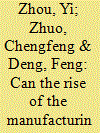|
|
|
Sort Order |
|
|
|
Items / Page
|
|
|
|
|
|
|
| Srl | Item |
| 1 |
ID:
177349


|
|
|
|
|
| Summary/Abstract |
Whether China could meet its 2030 energy conservation and emission reduction goals depends on whether energy efficiency serves as the most important measure of carbon emission reduction. This study has explored how industrial sector could achieve the goals on the premise of maintaining certain economic growth from the perspective of energy efficiency enhancement. The industrial correlation model and multi-objective optimization model are combined to find out the path of energy efficiency improvement, with the decision variables being economic output and energy intensity of various sub-sectors. Through intelligent optimization algorithm, nine paths of energy efficiency improvement are obtained and the corresponding optimal path is found out. The results indicate that regardless of the expected high-speed or medium-speed economic growth, the optimized path could achieve the goal of carbon emission peak, mainly depends on energy efficiency improvement. In the scenario of high-speed economic growth, the amount of CO2 emission could be reduced by 58.31% through energy efficiency enhancement, and further reduced by 28.22% through industrial restructuring; while in the medium-speed growth scenario, the CO2 emission amount could be reduced by 57.88% employing improving energy efficiency, and further be reduced by 29.44% employing industrial restructuring.
|
|
|
|
|
|
|
|
|
|
|
|
|
|
|
|
| 2 |
ID:
179671


|
|
|
|
|
| Summary/Abstract |
China is the largest country in energy consumption and carbon emissions. At the same time, with the continuous rise of China's manufacturing value chain, the impact of the manufacturing value chain on energy conservation and emission reduction is a very necessary and key research. This paper theoretically analyzes the impact of value chain climbing in manufacturing industry on energy conservation and emission reduction, and empirically tests the relationship between the two. This paper further explores the transmission mechanism between the two, and analyzes the hierarchical heterogeneity of the manufacturing industry.
|
|
|
|
|
|
|
|
|
|
|
|
|
|
|
|
| 3 |
ID:
178838


|
|
|
|
|
| Summary/Abstract |
This paper aims to provide new evidence on the relationship between green investment and firm performance through micro-level data. Data of energy listed firms in China from 2008 to 2017 are used here to explore this relationship. The research results show that green investment has a significant and positive correlation with financial performance, that is, increasing green investment helps improve financial performance. In the third year after investment in energy conservation and emission reduction, financial performance has been significantly improved. Additionally, environmental tax, government subsidies, and technological innovation have different positive moderating effects on green investment in promoting financial performance, and this result is more obvious in the long-term performance. Lastly, this paper finds that green investment helps reduce environmental violations and promote environmental performance, and environmental performance can strengthen the impact of green investment in improving the long-term performance of firms. This conclusion implies that firms should take environmental investment as its long-term strategy.
|
|
|
|
|
|
|
|
|
|
|
|
|
|
|
|
| 4 |
ID:
171419


|
|
|
|
|
| Summary/Abstract |
Aiming at the bi-level multi-objective characteristic of the energy-environment-economy(3E) system of China, this paper constructed a bi-level multi-objective optimization model. Six scenarios were simulated in preference to energy saving, emission reduction and economic development. And energy consumption, carbon emission and economic development were analyzed in different scenarios during the 13th five-year plan (2016–2020). The following results were obtained: during the 13th five-year plan, the national targets of energy consumption, carbon emission and economic development are easily achievable. However, it is hard for most regions to achieve their energy conservation and emission reduction (ECER) targets when accomplishing their own economic targets. In other words, regional economic targets mismatch their ECER targets. The effects of ECER are not ideal in the energy saving scenario and the carbon emission reduction scenario, while they are relatively satisfactory in the economic development scenario. The “win-win” situation between upper-level and lower-level is realizable in the economic development scenario, i.e., high-quality economic development may germinate good effects on ECER.
|
|
|
|
|
|
|
|
|
|
|
|
|
|
|
|
|
|
|
|
|